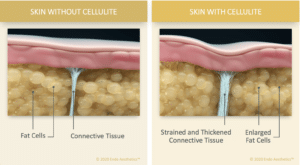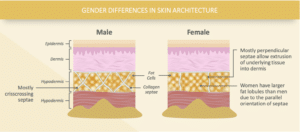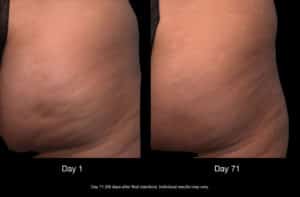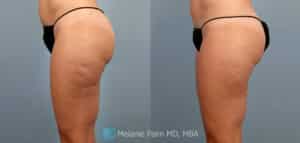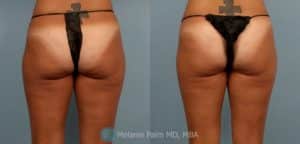Cellulite: Why it Happens and What Causes it?
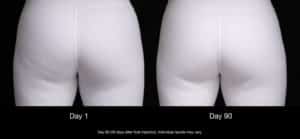
Cellulite is a frequently-used term that often refers to a group of skin irregularity conditions that range from skin laxity, orange peel appearance, cottage cheese irregularities, and even dimple-like lesions. Let’s explore more to discover what is cellulite, what are the underlying causes, and how we can best treat it!
What is Cellulite?
Cellulite affects somewhere between 85-95% of women following puberty. It is best described as skin irregularities and dimple-like lesions that occur most commonly on the buttocks and thighs. Wavy-like skin irregularities is not truly cellulite (although often thrown into that category), but is truly skin laxity and thinning. Diet and exercise have little effect on cellulite. Increases in weight can sometimes accentuate the appearance of cellulite, but inconsistently so. And … weight loss certainly does not eliminate the appearance of cellulite in the majority of women. I recently discussed the causes and possible treatment of cellulite with MSN and Yahoo here.
The cause of cellulite is complex. Hormones, circulation, and inflammation all play some role in the appearance and persistence of cellulite. Although the cause of cellulite is multifactorial and complex, the architectural cause of cellulite has been identified and is perhaps the most important contributing factor to dimple-like cellulite.
Sources:
-
- Sadick N. Treatment for cellulite. Int J Women’s Dermatol. 2019;5:68-72.
- Tokarska K, Tokarski S, Woźniacka A, et al. Cellulite: a cosmetic or systemic issue? Contemporary views on the etiopathogenesis of cellulite. Postepy Dermatol Alergol. 2018;35:442-446.
- Kaminer MS, Coleman WP III, Weiss RA, et al. A multicenter pivotal study to evaluate tissue stabilized-guided subcision using the Cellfina device for the treatment of cellulite with 3-year follow-up. Dermatol Surg. 2017;43:1240-1248.
- Hexsel D, Fabi SG, Sattler G, et al. Validated assessment scales for cellulite dimples on the buttocks and thighs in female patients. Dermatol Surg. 2019;45(suppl 1):S2-S11.
Fibrous septae: the structural cause of cellulite
The architectural cause of cellulite is related to collagen bands in the fat layer called fibrous septae. These bands run throughout the fat compartment, and in women they run vertically, or perpendicular to the skin’s surface. In men, they tend to run more horizontally or diagonally. Sophisticated anatomical studies identified these unique gender-specific differences in our fat compartment, in how it is organized, and the placement of these fibrous septae.
Fibrous septae connect the soft tissue and fat compartment to the under-surface of the skin. These collagen bands in women cause a tether-like, mattress-tufting on the skin surface. This pulling down by the fibrous septae on the skin’s surface leads to dimple-like depressions or cellulite. Therefore, it would make sense to target this structural cause of cellulite in formulating truly effective treatments for cellulite.
Sources:
-
- Kaminer MS, Coleman WP III, Weiss RA, et al. A multicenter pivotal study to evaluate tissue stabilized-guided subcision using the Cellfina device for the treatment of cellulite with 3-year follow-up. Dermatol Surg. 2017;43:1240-1248.
- Hexsel D, Abreu M, Rodrigues TC, et al. Side-by-side comparison of areas with and without cellulite depressions using magnetic resonance imaging. Dermatol Surg. 2009;35:1471-1477.
Cellulite: Today’s Treatment Options
Incredible stigma, shame, and social isolation has been studied and attributed to body image related to cellulite in women. For many decades, women have been instructed that diet and exercise (or lack there of it) was a cause of cellulite. As early as the 1930s, it was recommended by the medical community that proper fitness and food choices would eliminate cellulite … which was simply untrue.
It is critically important to distinguish dimple-like cellulite from other causes of skin irregularities such as skin laxity or unwanted fat deposits. Skin laxity is characterized by looseness of the skin and loss of dermal tissue support. Ultrasound, radiofrequency, and acoustic wave therapy are all effective means of heating the skin, targeting dermal thinning, and improving and tightening the skin envelope. Areas of unwanted fat can be treated with fat reduction procedures such as liposculpture, CoolSculpting, and EMSCULPT NEO. However, to tackle dimple-like cellulite, a different approach must be taken…
Skincare Choices for Cellulite and Skin Quality
Many of us have tried the deluge of topical skincare products that have been touted to improve cellulite. To our dismay, most of them are woefully disappointing in their lack of effect.
Skincare should not be the primary treatment of cellulite, but preserving the skin thickness and health over time are important in preventing skin laxity, collapse, and accentuation of cellulite irregularities.
The thickness of our dermis, the second layer of the skin, naturally decreases with age. It is also greatly affected by UV and environmental damage. Topical skincare is important to preserve, support, and maintain the health of the dermis and extracellular matrix. Use of topical skincare agents that incorporate appropriate SPF/physical sun blocking agents, retinols, glycolic acids, peptides, and moisturizing agents are essential in conjunction with in-office treatments to improve and preserve their results.
Releasing the Fibrous Septae to Treat Cellulite
Qwo: Chemical subcision of cellulite fibrous septae
In the summer of 2020, a new FDA-approved treatment for cellulite, Qwo, debuted to the aesthetic market. Qwo is collagenase clostridium histolyticum-aaes, an enzyme that selectively cuts or cleaves type I or type III collagen. These structural forms of collagen compose the fibrous bands, the structural cause of cellulite. Through a process called enzymatic subcision and repair (ESR), Qwo snips the fibrous septae and allows finer, more delicate collagen networks to re-grow within the fat compartment, leading to a smoother skin appearance and improvement of dimple-like cellulite.
Qwo is something familiar to myself and Art of Skin MD. I am honored to participate as a clinical investigator in the phase IIIB trials for Qwo treatment. Currently, Qwo is FDA-approved for the treatment of moderate to severe cellulite on the buttocks of adult women. It is completed as a series of typically 3 treatments, spaced about 3 weeks apart. Currently, it has a duration of 12 months, but it is likely that this is a long-lasting effect as Qwo attacks the structural cause of cellulite.
Cellfina: Tissue-stabilized subcision of cellulite dimples
Cellfina is the first tissue-stabilizing, vacuum-assisted in-office procedure to treat dimple-like cellulite. It has demonstrated from clinical data submitted to the FDA 5 years of duration.
As opposed to Qwo, Cellfina is completed as a single, minimally invasive procedure rather than a series of treatments. Cellfina involves a three step process:
1. Marking and photographing the dimples to be treated
2. Providing dilute tumescent anesthesia to the area to be treated
3. A controlled mechanical subcision of the cellulite dimple’s fibrous septae
Cellfina provides a mechanical rather than enzymatic subcision of fibrous septae, the architectural cause of cellulite dimples. It is highly effective with high patient satisfaction scores.
The Cellfina procedure takes much longer to complete in the office than a Qwo injection session. However, Cellfina requires a single treatment, while Qwo involves a series of injection sessions. Both methods are highly effective, and patient circumstances and preferences guide the treatment choice.
Cellulite treatment with Collagen Stimulators
Collagen stimulators are injectables used on the face and body to promote our own body to produce collagen. Sculptra (poly-L-lactic acid) and Radiesse (calcium hydroxylapatite) can be used in more blended formulations to stimulate collagen growth to the dermis, or more concentrated forms can be used to fill or camouflage skin irregularities including cellulite.
Radiesse to right buttock region
Cellulite: How to treat it today with advanced techniques
Art of Skin MD offers many advanced techniques and procedures for your body concerns. Injectable collagen stimulators, Qwo, Cellfina, Emtone, and EMSCULPT NEO can be utilized in unique ways to refresh skin laxity, cellulite, skin firmness, volume loss, and muscle tone.
If you would like to learn more about cellulite treatments such as Qwo and Cellfina at Art of Skin MD, email us at info@artofskinmd.com or call us at 858.792.7546 (SKIN).

